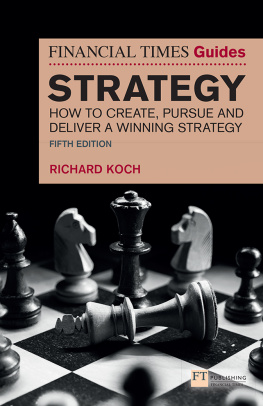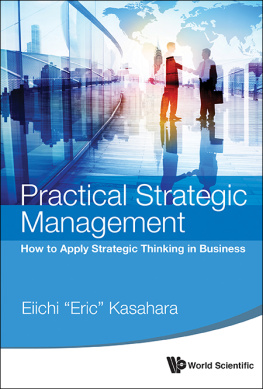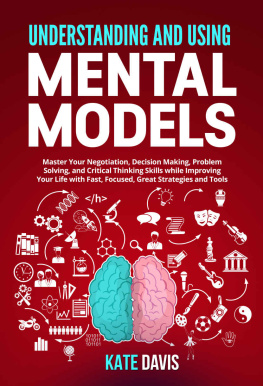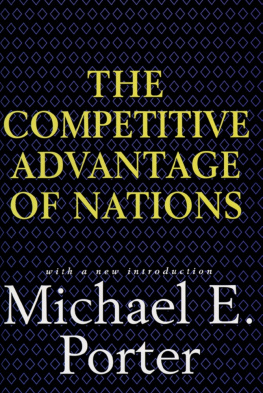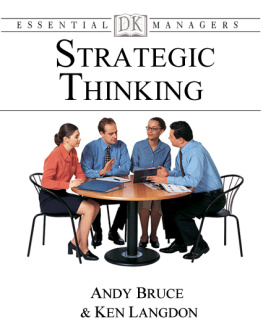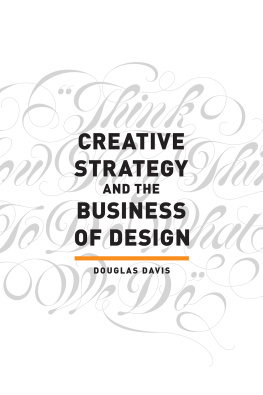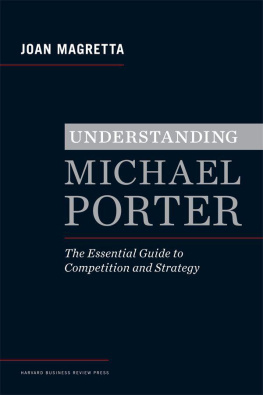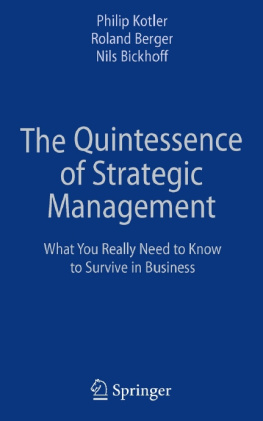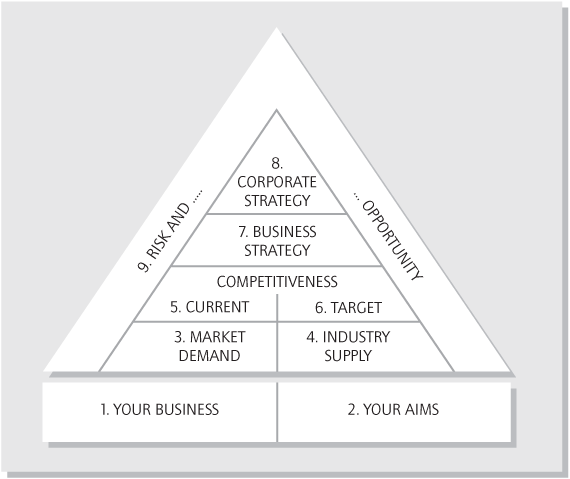Strategy has a myriad of definitions. General Sun Tzu in the 6th century BC defined it as know your opponent, while rather more recently Kenichi Ohmae summed it up as in a word, competitive advantage (thats actually two words, but whos counting?!).
I am an economist by training, so feel the need to bring the word resources into a broader definition. Economics is succinctly defined as the optimal allocation of a nations scarce resources. Thus, at the micro-economic level: Strategy is how a firm achieves its goals by deploying its scarce resources to gain a sustainable competitive advantage.
The tools here are not arranged randomly, nor are they listed in some meaningless order such as by the originators alphabetical name.
They are presented in the order in which they would be deployed typically in a strategy development process.
One such process introduced in this books more voluminous companion, Key Strategy Tools (referred to above), is the Strategy Pyramid. This consists of nine building blocks (see ).
Figure 0.1 The nine building blocks of the Strategy Pyramid
The tools of this book are set out following the same process:
Block 1 Knowing your business see of this book
Block 2 Setting goals and objectives see Tools (including Collins and Porrass big, hairy, audacious goals)
Block 3 Forecasting market demand see
Block 4 Gauging industry competition see (Porters five forces, of course!)
Block 5 Tracking competitive advantage see Tools
Block 6 Targeting the strategic gap see Tools
Block 7 Bridging the gap with business strategy see Tools (including Kim and Mauborgnes blue ocean strategy)
Block 8 Bridging the gap with corporate strategy see Tools (including tools from Hamel and Prahalad, Mintzberg, Christensen and Rumelt)
Block 9 Addressing risk and opportunity see .
You can read 25 Need-to-Know Strategy Tools either from beginning to end, following a logical strategy development process, or you can just dip in and out, when you want as you please.
But remember that this book doesnt cover everything there is to know about strategy if you need to know more, some further reading is suggested at the end of the book.
Do not be dismayed by strategy or strategic thinking. I often meet business folk who preface their strategic insights by saying: Unfortunately I have never had any training in strategy, but what I think is
Such humility is endearing but misplaced. Strategy is 90 per cent common sense. That many managers and entrepreneurs treat it with such awe is partly down to my own profession of strategy consulting. It is, I am afraid, in the commercial interests of many of my peers to maintain the myth.
Not so in this book. You will find that it is written in an easy-to-read style. Jargon is avoided wherever possible. And tools are related to the real world.
I have chosen tools that will help you in your business. These are not tools that are just clever, designed to give one smart professor at one prominent business school bragging rights over another. These are tools that can be used by you.
Pocket the huge sums that you would otherwise pay to consultants. Read this book and let it be your guide on how to use strategy tools for the benefit of your business.
To help you on the way, I have added one case study per tool of how one company, typically well known, has used the tool effectively or, in some cases, should have used it!
Strategy is all about direction. You want to get your business from where it is today to where you want it to be tomorrow.
Let this book help you get there.
Enjoy!
Business vs corporate strategy
One thing we need to address upfront is how this book approaches the two distinct, but related, fields of strategy: business strategy and corporate strategy. A business, or, more technically, a strategic business unit (SBU), is defined as an entity with a closely inter-related product (or service) offering and a cost structure largely independent of other business units. Thus, in a large, multi-business corporation, an SBU may well have not only its own CEO, CFO, COO, CSMO and CIO, but its own CTO, head of all R&D in that SBU.
An SBU is an entity substantive enough to warrant drawing up its own strategy, independent of strategies its fellow SBUs may be drawing up.
SBU strategy is known more simply as business strategy. Tools of this book deal with business strategy.
Corporate strategy is, in the first instance, how you allocate resources between your businesses. Which will you invest in, which will you hold for cash generation, which will you sell, which may you be forced to close down? This is corporate strategy as portfolio planning see , Optimising the corporate portfolio.






